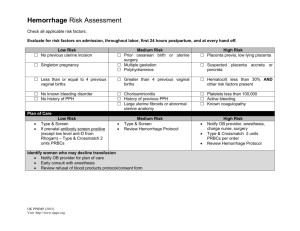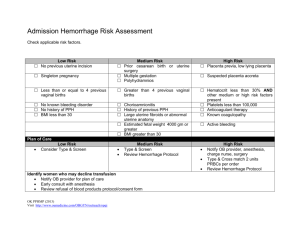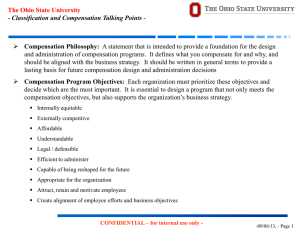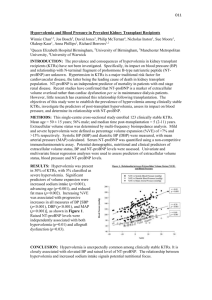BREACH blood volume and hematocrit
advertisement
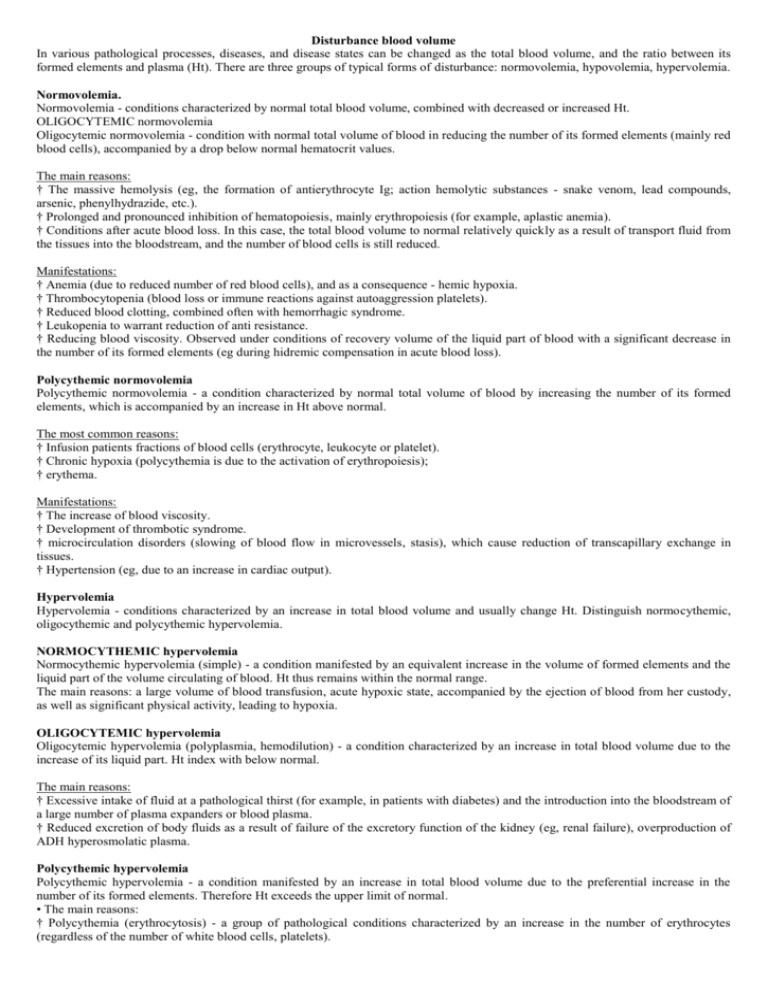
Disturbance blood volume In various pathological processes, diseases, and disease states can be changed as the total blood volume, and the ratio between its formed elements and plasma (Ht). There are three groups of typical forms of disturbance: normovolemia, hypovolemia, hypervolemia. Normovolemia. Normovolemia - conditions characterized by normal total blood volume, combined with decreased or increased Ht. OLIGOCYTEMIC normovolemia Oligocytemic normovolemia - condition with normal total volume of blood in reducing the number of its formed elements (mainly red blood cells), accompanied by a drop below normal hematocrit values. The main reasons: † The massive hemolysis (eg, the formation of antierythrocyte Ig; action hemolytic substances - snake venom, lead compounds, arsenic, phenylhydrazide, etc.). † Prolonged and pronounced inhibition of hematopoiesis, mainly erythropoiesis (for example, aplastic anemia). † Conditions after acute blood loss. In this case, the total blood volume to normal relatively quickly as a result of transport fluid from the tissues into the bloodstream, and the number of blood cells is still reduced. Manifestations: † Anemia (due to reduced number of red blood cells), and as a consequence - hemic hypoxia. † Thrombocytopenia (blood loss or immune reactions against autoaggression platelets). † Reduced blood clotting, combined often with hemorrhagic syndrome. † Leukopenia to warrant reduction of anti resistance. † Reducing blood viscosity. Observed under conditions of recovery volume of the liquid part of blood with a significant decrease in the number of its formed elements (eg during hidremic compensation in acute blood loss). Polycythemic normovolemia Polycythemic normovolemia - a condition characterized by normal total volume of blood by increasing the number of its formed elements, which is accompanied by an increase in Ht above normal. The most common reasons: † Infusion patients fractions of blood cells (erythrocyte, leukocyte or platelet). † Chronic hypoxia (polycythemia is due to the activation of erythropoiesis); † erythema. Manifestations: † The increase of blood viscosity. † Development of thrombotic syndrome. † microcirculation disorders (slowing of blood flow in microvessels, stasis), which cause reduction of transcapillary exchange in tissues. † Hypertension (eg, due to an increase in cardiac output). Hypervolemia Hypervolemia - conditions characterized by an increase in total blood volume and usually change Ht. Distinguish normocythemic, oligocythemic and polycythemic hypervolemia. NORMOCYTHEMIC hypervolemia Normocythemic hypervolemia (simple) - a condition manifested by an equivalent increase in the volume of formed elements and the liquid part of the volume circulating of blood. Ht thus remains within the normal range. The main reasons: a large volume of blood transfusion, acute hypoxic state, accompanied by the ejection of blood from her custody, as well as significant physical activity, leading to hypoxia. OLIGOCYTEMIC hypervolemia Oligocytemic hypervolemia (polyplasmia, hemodilution) - a condition characterized by an increase in total blood volume due to the increase of its liquid part. Ht index with below normal. The main reasons: † Excessive intake of fluid at a pathological thirst (for example, in patients with diabetes) and the introduction into the bloodstream of a large number of plasma expanders or blood plasma. † Reduced excretion of body fluids as a result of failure of the excretory function of the kidney (eg, renal failure), overproduction of ADH hyperosmolatic plasma. Polycythemic hypervolemia Polycythemic hypervolemia - a condition manifested by an increase in total blood volume due to the preferential increase in the number of its formed elements. Therefore Ht exceeds the upper limit of normal. • The main reasons: † Polycythemia (erythrocytosis) - a group of pathological conditions characterized by an increase in the number of erythrocytes (regardless of the number of white blood cells, platelets). † Polycythemia vera (polycythemia vera, a disease Vaquez) - chronic leukemia with a lesion at the level of progenitor cells with characteristic myelopoietic unlimited proliferation of tumor cells retained the ability to differentiate four germs, especially the red. Erythremia accompanied by significant erythrocytosis and as a consequence - increased Ht. † Chronic hypoxia of any type (hemic, respiratory, circulatory, tissue, etc.). Polycythemia reflects hyperregeneratic state bone marrow, which is accompanied by increased proliferation of blood cells, especially red blood cells, and release them into the bloodstream. Polycythemic hypervolemia revealed in chronic heart failure, alveolar hypoventilation, lowering blood oxygen capacity and efficiency of biological oxidation, when exogenous (norms and hypobaric) hypoxia. SYMPTOMS: † The increase in cardiac output. Is the result of compensatory hyperfunction of the heart due to increased blood volume. However, decompensated heart failure and development of cardiac output, it is usually reduced. † Increased blood pressure. Due mainly to an increase in cardiac output, as well as the volume circulating of blood and the tone of resistance vessels. † Increased blood viscosity. † Elevated aggregation and agglutination of blood cells. † Disseminated thrombosis. † microcirculation disorders. Hypovolemia Hypovolemia - states characterized by a decrease in the total blood volume, and generally the ratio of its breach formed elements and plasma. Distinguish normocytemic, oligocytemic polycythemic and hypovolemia. NORMOCYTHEMIC hypovolemia Normocythemic hypovolemia - a condition manifested by a decrease in total blood volume while maintaining Ht within normal limits. The most common reasons: † Acute hemorrhage. † state of shock, vasodilatory collapse. In the latter two cases normocythemic hypovolemia is caused deposition of a large volume of blood in the venous (capacitive) vessels and a significant reduction in connection with the BCC. Manifestation: Determined by the nature of the reasons that caused it (blood loss, shock, collapse), as well as the inclusion of compensatory mechanisms aimed at addressing the acute hypoxia. OLIGOCYTHEMIC hypovolemia Oligocythemic hypovolemia - a condition characterized by a decrease in total blood volume with a primary decrease in the number of its formed elements. Ht with below normal. The most common reasons: † Conditions after acute blood loss (at that stage, when the transport fluid from the tissues and blood output deposited in the bloodstream has not eliminate hypovolemia, and delivery of blood cells from hematopoietic organs - deficiency of red blood cells). † eritropenia as a result of massive hemolysis of erythrocytes (eg, burns a large area of the body when combined with the loss of hemolysis body liquid part of blood in connection with plasmorrhages) and suppression of erythropoiesis (for example, aplastic or aregeneration states). Manifestation: † Reduction measure blood oxygen capacity (as a result eritropeniya). † signs of hypoxia (for example, lowering blood oxygen, acidosis, decrease venous blood PO2, etc.). † Disorders organ-tissues circulation and microcirculation of varying degrees caused by, among other factors, a decrease in BCC. Polycythemic hypovolemia Polycythemic hypovolemia - a condition in which the lowering of total blood volume in the organism caused mainly by the decrease in plasma volume. Indicator Ht In this state above the normal range. The most common reasons: † Conditions causing increased loss of body fluids: repeated vomiting (for example, pregnant or as a result of exogenous intoxication), prolonged diarrhea (eg, breach of membrane digestion, intestinal poisoning), polyuria (eg, renal failure), elevated and prolonged sweating (for example, in hot climates or in hot shops in the workplace) and extensive skin burns (accompanied plasmorrhages). † condition that prevents adequate intake of fluids in the body (water " starvation "): lack of drinking water and the impossibility of drinking water (for example, as a result of muscle spasms of tetanus or rabies). Manifestation: † organ-tissues microcirculation disorders due to hypovolemia and polycythemia. † Increased blood viscosity, aggregation of blood cells in the microvasculature of organs and tissues and disseminated microtrombosis. † Signs underlying pathology causing polycythemic hypovolemia (e.g. shock, diabetes insipidus, renal failure, burns, etc.). Blood loss. Blood loss - a condition characterized by loss of body parts blood. While developing complex pathogenic and adaptive reactions of the organism, the totality of which is called the state after hemorrhage. This condition manifests disorder living organism varying degrees (depending on the amount of blood loss and reactivity). Blood loss is the result of bleeding (haemorrhage) - the outpouring of blood from the blood vessels and / or cavities of the heart into the environment (external bleeding) or in body cavities (internal, cavitary bleeding). The presence of blood in the cavities of the body designated by special terms. • Hemothorax - blood in the pleural cavity. • Hemopericardium - blood in the pericardial cavity. • Hemoperitoneum - effusion of blood in the abdominal cavity. • Hemarthrosis - blood in the joint cavity. Bleeding should be distinguished from hemorrhage and hematoma. • Hemorrhage - focal or diffuse permeation of tissues (eg, subcutaneous tissue, muscle) blood. • Hematoma - local accumulation of blood in the tissue. Hemorrhage and hematoma of the vascular bed goes relatively small volume of blood disorders and significant systemic circulation is not observed. Developing disorders in the body are mainly determined by the role of the organ or tissue, in which hemorrhage occurred or in which the formed hematoma (brain, liver, kidney, muscle, subcutaneous tissue). Types of blood loss: 1) on the damaged vessels or chambers of the heart : arterial venous capillary Mixed 2) the volume of blood lost Light ( 25% of blood volume ) Medium ( 25-35 %) Heavy ( more than 35-40 %) 3 ) at the start time after the injury krovrotecheniya Initial Resale 4 ) at the outpouring of blood Outdoor internal Etiology The most frequent reasons BLOOD LOSS • Violation of the integrity of the walls of blood vessels or heart by mechanical action (eg, cut or tear the wall), purulent melting vessel walls or destruction of its growing tumor, break walls of the ventricles or atria in the area of myocardial infarction or aneurysm. • A significant increase in the permeability of the vessel walls, particularly the microvasculature. Observed in radiation sickness, extramedullary hematopoiesis foci (eg, patients with leukemia), infectious processes (eg, typhus, sepsis), severe hypovitaminosis C (scurvy). • Significant reduction in blood clotting. This circumstance (especially in combination with high permeability of microvessels wall) can lead to significant loss of blood by the body (e.g., uterine and gastro-intestinal bleeding). Conditions affecting the course and outcome of BLOOD LOSS 1. Features of blood loss. a) The volume of blood lost. - yield of vascular bed until 20-25% of BCC, usually dangerous and not offset due to the incorporation of compensation mechanisms emergency. - Loss of 25-35% of BCC is associated with significant disorders of the central, organ-tissues and microcirculation. - Loss 50 % or more of total blood volume (especially fast) is lethal. b) The rate of blood loss. The lower the rate of blood loss, the less severe disorder of life. Thus, even a loss of half of the total blood for several days (the mother, gastric, and other types of hemorrhoidal bleeding) usually do not lead to death. 2. The ratio of active coagulation factors, anticoagulant and fibrinolytic systems. Decreased activity or content of coagulation factors and / or an increase in anticoagulant and fibrinolytic systems, leading to a decrease in blood clotting can cause an increase in the speed and volume of blood loss, which exacerbates its course and consequences. 3. Reactivity. For and consequences of blood loss to a large extent depend on the reactivity of the organism, defined gender (women are less sensitive to blood loss), age (in adults, blood loss is easier than children), the current state of the body (when overheating or cooling effects of blood loss harder than at normal temperature; under deep anesthesia life disorders are more pronounced than in the waking state). Pathogenesis Basic pathogenesis postgemorragic states. Hemorrhage → Decrease in blood volume → Reduced inflow of venous blood to the heart → Reducing shock and cardiac output → Lowering blood pressure → Decrease in perfusion pressure in the vessels→ microcirculatory disorders → Hypoperfusion of organs and tissues → Сapillotrophic failure → Hypoxia , toxemia , acidosis, disionia → disturbance of energy and plastic security cells → multiorgan failure → Disorder living organism At the initial stage of blood loss greater or at least reduced, while maintaining normal volume of blood circulation, Ht, i.e. develops normocythemic hypovolemia. In this connection, reduced inflow of venous blood to the heart, stroke volume and cardiac output. This leads to a drop in blood pressure and as a consequence - the pressure receptacles perfusion of organs and tissues. This reduces the transport of oxygen and metabolic substrates to the cells of the blood and from the latter - of carbon dioxide and metabolic products. Developing capillary- trophic failure, intoxication products disturbed metabolism, hypoxia. This, in turn, causes a disorder of cells and provide energy plastic processes them. Disrupted the function of organs and tissues that are often accompanied by severe a greater or lesser extent their failure. Significantly upset functioning of the organism as a whole. The extreme degree of these disorders is referred to as posthemorrhagic shock. Disturbance of systemic hemodynamics and reducing the intensity of biological oxidation in cells determines the inclusion or activation of adaptive mechanisms. ADAPTIVE MECHANISMS The main mechanisms of adaptive compensation of blood loss include: • Activation of coagulation and thrombotic process. • Reactions cardiovascular compensation hemorrhage (bleeding hydremic compensation): narrowing of resistance vessels, ejection of blood from the depot, increased cardiac output, maintaining the bcc to the highest possible level (by entering the interstitial fluid from the blood vessels, as well as - lymph flow). • Restoration of blood protein (due to synthesis in the liver) - reaction protein compensation of blood loss. • Eliminating the deficit of blood cells due to activation of hematopoietic cell -, bone marrow compensation. • Activation of emergency and long-term mechanisms of adaptation to hypoxia. COMPENSATION UNDER BLOOD LOSS The above mechanisms are activated at different times after hemorrhage, in this regard are the following stages of development processes blood loss compensation: the cardiovascular, hydremic, proteinsintetic and medullary. However, many processes are mentioned in the body is not strictly in series (by stages), and more often - in parallel, coinciding in time and usually potentiating each other. This contributes to more rapid and effective elimination of the consequences of blood loss. Cardiovascular compensation. Develops in the first seconds after the onset of bleeding. Stage cardiovascular compensation is to stimulate the heart and changes in tone and arteriolar lumen. † Stimulation of the heart provides: ‡ increase in heart rate and increased stroke volume (usually) ‡ increase (due to the above changes) integral indicator of heart function - cardiac output (however, with significant blood loss may be lower than it needs). Reason: activation (in terms of circulatory and hemic hypoxia and initially decreased cardiac output) sympathoadrenal system. † Change tone and arteriolar lumen cause the development of the phenomenon of " centralization of blood flow," in which: ‡ heart and brain blood vessels dilate, the blood flow and the volume of which decreases slightly in or remains within the normal range. The main reasons: § Fast and significant factors in the formation of vasodilating action: adenosine, Pg, kinins, NO. § Changing the physicochemical properties of the cells and interstitial fluid in said bodies, including - on the walls of the vessels: accumulation in the cells and the interstitial ions H +, the output of cells ions K +, an increase in their contents of Na +, Ca2 + and other ions. These and other changes to help reduce the tone of arterioles and maintaining the priority of blood supply to the heart and brain. ‡ arterial vessels of the subcutaneous tissue, skin, muscles, abdominal organs, kidneys and other tissues and organs are narrowed and blood flow to them is significantly reduced. Increased arteriolar tone in these organs and tissues also causes the release of deposited blood into the bloodstream and increase the BCC. At the stage of cardiovascular compensation still remains normocythemic hypovolemia. Hydremic compensation In the first minutes after hemorrhage activated mechanisms to ensure activation of the current fluid from the tissues into the bloodstream. An initial factor - reduction of volume circulating of blood. Hydremic compensation mechanism. Central to this are vasopressin (ADH) and aldosterone. † Hypovolemia stimulates the secretion of ADH through the carotid baroreceptors area. ‡ ADH regulates the activity formed aquaporin -2 water channel in collecting duct. It enhances reabsorption of water from the lumen of the collecting tubules in the intercellular space. ‡ Under the influence of ADH narrows the lumen of the interlobular arteries and arterioles bringing nephrons. This reduces the glomerular filtration, which also helps reduce the degree of hypovolemia. ‡ ADH reduces blood flow to the cells by glomerular complex (juxtaglomerular apparatus). In this regard, increased secretion of renin, with its participation formation of angiotensin II. Last toning causes arterioles, stimulation of the release of catecholamines and activation of aldosterone secretion. † Increased aldosterone levels in the blood stimulates Na + reabsorption in the renal tubules of the kidneys. In this regard, developing hyperospheresia plasma that activates osmoreflex. Excitation osmoreceptors vascular bed stimulates the secretion of ADH hypothalamic neurons, providing increased fluid flow into the bloodstream and the restoration of the lost volume of the liquid part of blood. † Simultaneously with the above-described changes of the fluid flow is activated in the extracellular space of the cells (at an osmotic pressure gradient) in the lymph capillaries and then - in the blood. In step hydremic compensation (2-3 days after hemorrhage) observed oligocythemic hypo- or normovolemia. Entering the bloodstream interstitial fluid contains minimal compared with plasma protein. It stimulates the body synthetic processes. Protein compensation. Realized due to the activation in the liver and proteosintesis detected within a few hours after bleeding. Later signs of increased protein synthesis recorded for 1.5-3 weeks or more depending on the amount of blood loss and the state of reactivity. Among other proteins, are synthesized in the liver and procoagulants. This is combined with the activation reactions homeostasis. Last contributes to the so-called hemostatic potential defect thrombosis of the vascular bed and reduce the intensity or stop bleeding. The cell (bone marrow) compensation Causes ‡ Hypoxia. It is mixed and is essentially a hemic, circulatory, respiratory (the latter developed in connection with a reduction in the magnitude of pulmonary perfusion). ‡ Physicochemical changes in biological tissues and liquids (increase of H +, Na +, ATP hydrolysis products, etc.). These and other changes to stimulate the synthesis of substances that activate the proliferation of hematopoietic cells in the bone marrow and lymphoid tissue. The leading role of these substances is erythropoietin. TYPES OF BLOOD LOSS Depending on the damaged vessel or heart chamber, the volume of blood loss, bleeding time, place the following types of hemorrhage hemorrhage. Internal - bleeding in the body cavities or organs PRINCIPLES AND METHODS OF TREATMENT OF BLOOD LOSS Causal Principle To stop blood loss (reduction of its power) necessary to act on the cause of blood loss - to restore the integrity of the vessel wall or heart, increase blood clotting. pathogenetic principle • To restore the bcc is necessary to eliminate or reduce the degree of disorder of the central and organ-tissues circulation (by transfusion of blood, plasma, plasma substitutes). • To normalize the transcapillary exchange should remove or reduce the degree of microcirculatory disorders (infusion of plasma substitutes). • In order to eliminate or reduce the degree of shift of water, protein and ionic imbalance necessary (in addition to restoring and normalizing bcc transcapillary exchange) administered solutions containing proteins and ions in an amount and ratio of eliminating imbalance in the body. • To correct the acid base balance should normalize its performance. For this reduced volume circulating of blood, remove or reduce the degree of microcirculatory disorders, administered buffers and normalize (activate) the function of compensating shifts acid base balance. Symptomatic principle Necessary to carry out activities aimed at normalizing the functions of organs and systems are broken as a result of blood loss and hypoxia (CAS, respiratory system, kidneys, liver, etc.).


